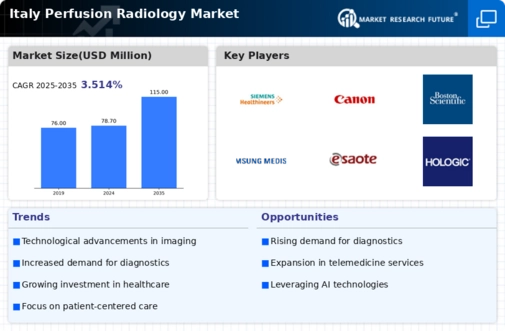Investment in Healthcare Infrastructure
Italy's ongoing investment in healthcare infrastructure significantly impacts the perfusion radiology market. The government has allocated substantial funds to modernize healthcare facilities, aiming to enhance diagnostic capabilities and patient care. Recent reports indicate that healthcare spending in Italy is projected to grow by approximately 4% annually, with a notable portion directed towards advanced imaging technologies. This investment is likely to facilitate the acquisition of cutting-edge perfusion imaging systems, which are essential for accurate diagnosis and treatment planning. Additionally, the establishment of specialized centers for cardiovascular care is expected to increase the demand for perfusion radiology services. As healthcare facilities upgrade their infrastructure, the perfusion radiology market is poised for growth, driven by the need for improved diagnostic tools and enhanced patient management.
Technological Integration in Healthcare
Advanced technologies are transforming the landscape of the perfusion radiology market. Innovations such as artificial intelligence (AI) and machine learning are being increasingly utilized to enhance imaging techniques and improve diagnostic accuracy. In Italy, healthcare institutions are beginning to adopt these technologies to streamline workflows and optimize patient outcomes. The application of AI in perfusion imaging can assist radiologists in interpreting complex data more efficiently, potentially leading to quicker diagnoses. As these technologies continue to evolve, they are likely to play a crucial role in shaping the future of the perfusion radiology market. The ongoing collaboration between technology developers and healthcare providers may further accelerate the adoption of these advanced imaging solutions, ultimately benefiting patient care.
Rising Incidence of Cardiovascular Diseases
The increasing prevalence of cardiovascular diseases in Italy is a primary driver for the perfusion radiology market. According to recent health statistics, cardiovascular diseases account for approximately 35% of all deaths in the country. This concerning trend necessitates advanced diagnostic tools, including perfusion imaging, to enhance patient outcomes. As healthcare providers seek to improve diagnostic accuracy and treatment efficacy, the demand for perfusion radiology services is expected to rise. Furthermore, the Italian healthcare system is increasingly adopting innovative imaging technologies to facilitate early detection and intervention, thereby potentially reducing the burden of cardiovascular diseases. This growing focus on cardiovascular health is likely to propel the perfusion radiology market forward, as hospitals and clinics invest in state-of-the-art imaging equipment and training for healthcare professionals.
Regulatory Changes Favoring Advanced Imaging
Recent regulatory changes in Italy are favoring the adoption of advanced imaging techniques, including those used in the perfusion radiology market. The Italian government has implemented policies aimed at promoting the use of innovative diagnostic tools to improve healthcare delivery. These regulations are designed to streamline the approval process for new imaging technologies, making it easier for healthcare providers to access state-of-the-art equipment. As a result, hospitals and clinics are more likely to invest in advanced perfusion imaging systems, which can enhance diagnostic capabilities and patient management. The supportive regulatory environment is expected to stimulate growth in the perfusion radiology market, as healthcare facilities seek to comply with new standards and improve their diagnostic offerings.
Growing Awareness of Non-Invasive Diagnostic Techniques
There is a notable increase in awareness regarding non-invasive diagnostic techniques among both healthcare professionals and patients in Italy. This trend is particularly relevant to the perfusion radiology market, as non-invasive imaging methods are preferred for their safety and efficacy. Educational campaigns and professional training programs have contributed to this heightened awareness, leading to a greater acceptance of perfusion imaging as a standard diagnostic tool. As patients become more informed about their treatment options, the demand for non-invasive procedures is likely to rise. This shift in patient preference may encourage healthcare providers to adopt advanced perfusion imaging technologies, thereby expanding the market. The emphasis on patient-centered care and the desire for less invasive diagnostic alternatives are expected to drive growth in the perfusion radiology market.

















Leave a Comment